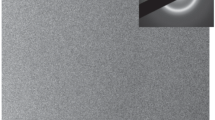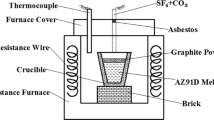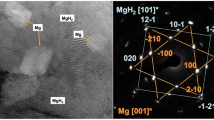Abstract
Thin ribbons of the metallic glass Mg65Cu25Y10, obtained by spinning, were saturated with atomic hydrogen from electrochemical decomposition of water. The maximum amount of absorbed hydrogen was 4 mass %. The hydrogen content was determined by hot extraction. We studied the microstructure of samples with different hydrogen contents by x-ray phase analysis (from the change in the diffuse maximum), atomic force microscopy, scanning electron microscopy, and transmission electron microscopy. When the hydrogen content increases up to 3.6 mass %, the amorphous structure of the Mg65Cu25Y10 alloy is converted to a nanocrystalline structure, with formation of magnesium and yttrium hydrides at room temperature.
Similar content being viewed by others
REFERENCES
B. A. Kolachev, R. E. Shalin, and A. A. Il’in, Hydrogen-Storing Alloys [in Russian], Metallurgiya, Moscow (1995).
J. J. Reilli and R. H. Wiswall, “The reaction of hydrogen with alloys of magnesium and copper,” Inorganic Chemistry, 6, 2220–2223 (1967).
J. J. Reilli, “Metal hydride technology,“ Zeitschrift für Physikalische Chemie, Neue Folge [New Series], 117, 155–184 (1979).
J. Genossar and P. S. Rudman, “The catalytic role of Mg2Cu in the hydriding and dehydriding of Mg,” Zeitschrift für Physikalische Chemie, Neue Folge [New Series], 116, 215–224 (1979).
A. Seiler, L. Schlapbach, Th. von Waldrich et al., “Surface analysis of Mg2Ni—Mg, Mg2Ni, Mg2Cu,” J. Less-Comm. Met., 73, 193–199 (1980).
A. Zaluska, L. Zaluski, and J. O. Strom-Olsen, “Nanocrystalline magnesium for hydrogen storage,” J. Alloys Comp., 288, 217–225 (1999).
G. G. Perrault, “Corrosion mechanisms of magnesium alloys,” Electroanal. Chem. Interfac. Electrochem., 51, 107 (1974).
I. G. Konstanchuk, E. Yu. Ivanov, and V. V. Boldyrev, “Reaction of hydrogen with alloys and intermetallics obtained by mechanochemical methods,” Usp. Khimii, 67, 75–87 (1998).
A. Inoue and T. Masumoto, “Mg-based amorphous alloys,” Mat. Sci. Eng., A173, 1–8 (1993).
A. Inoue, A. Kato, T. Zhang et al., “Mg - Cu - Y amorphous alloys with high mechanical strengths produced by a metallic mold casting method,” Mat. Trans. Jpn. Inst. Met., 32, 609–616 (1991).
A. Gebert, U. Wolff, M. Savyak et al., “Stability and electrochemical properties of Mg65Cu25Y10 metallic glass,” Mat. Sci. Forum, 377, 9–14 (2001).
J. Eckert J., “Massive amorphous metals,“ Wissenschaftliche Zeitschrift der Technischen Universität Dresden, 46, No. 3, 86–90 (1997).
K. Suzuki, H. Fujimori, and K. Hashimoto, Amorphous Metals [Russian translation from Japanese], Metallurgiya, Moscow (1987).
M. Savyak, S. Hirny, H.-D. Bauer et al., “Electrochemical hydrogenation of Mg65Cu25Y10,” J. Alloys Comp., 364, 229–237 (2004).
O. S. Lytvyn, V. S. Khomchenko, T. G. Kryshtab, and P. M. Lytvyn, “Structural investigations of annealed ZnS:Cu, Ga film phosphors,” Semiconductor Physics. Quantum Electronics Optoelectronics, 4, No. 1, 19–23 (2001).
V. P. Klad’ko, O. S. Lytvyn, and P. M. Lytvyn, “Recrystallisation processes in screen-printed CdS films,” Semiconductor Physics. Quantum Electronics Optoelectronics, 5, No. 2, 170–175 (2002).
K. N. Semenenko, V. A. Yartys’, and V. V. Burnasheva, “«Deformability» of a crystal lattice and the ratio of intermetallic compounds to hydrogen,” Dokl. Akad. Nauk SSSR, 245, No. 5, 1127–1130 (1979).
V. A. Yartys, I. R. Harris, V. V. Panasyuk, “Novel metal hydrides. A review,” Mat. Sci., 29, 100–116 (2001).
J. Güntherodt and H. Beck, Glassy Metals. Ionic Structure, Electronic Transport and Crystallisation, Springer, Berlin; New York (1981).
Author information
Authors and Affiliations
Additional information
Translated from Poroshkovaya Metallurgiya, No. 9–10(439), pp. 87–94, September–October, 2004.
Rights and permissions
About this article
Cite this article
Savyak, M.P., Gebert, A. & Uhlemann, M. Effect of hydrogen on the amorphous structure of the alloy Mg65Cu25Y10 under electrochemical saturation. Powder Metall Met Ceram 43, 513–519 (2004). https://doi.org/10.1007/s11106-005-0014-5
Received:
Issue Date:
DOI: https://doi.org/10.1007/s11106-005-0014-5




